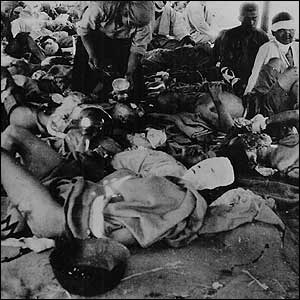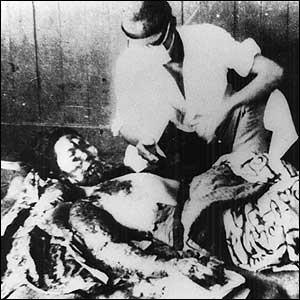
August 06, 1945
Dr. Ferufumi Sasaki walked around one of the corridors of the huge Red Cross Hospital with a blood specimen for a test.
Mrs. Hatsuyo Nakamura, a tailor’s widow, was watching a neighbor tear down his house.
Ms. Toshinki Sasaki, a clerk working at East Asia Tin Works, turned her head to talk to the girl working next to her.
The Reverend Mr. Kiyoshi Tanimoto, pastor of the
Dr. Masakazu Fujii sat down to read the
Father Wilhelm Kleinsorge lay on a cot, reading a Jesuit magazine, Stimmen der Zeit.
The next thing all of them remember was seeing a brilliant white light. When they came back to their senses, they were amongst ruins. The day was dark.

 Captain Robert Lewis, co-pilot of the Enola Gay, the B-29 that dropped the bomb (nicknamed Little Boy), wrote in his log, “My God, what have we done?”
Captain Robert Lewis, co-pilot of the Enola Gay, the B-29 that dropped the bomb (nicknamed Little Boy), wrote in his log, “My God, what have we done?”
Children started shivering heavily and stopped suddenly, dead. Men and women who were burnt and bleeding profusely were unusually quiet, only moaning softly for water. The bomb left about a hundred thousand people dead. Many were and still are physically and mentally affected.
Written by Pulitzer Prize winning author John Hersey,
The author went back to
Hersey’s narrative is engrossing. His description of
The book is disturbing to a certain extent and hence may not go down well with some people. Reading a book dealing entirely with a catastrophe and it’s aftermath can be harrowing for some people. But for people like me who feel strongly about war and it’s disastrous consequences, this book fuels the fire within.
--
© Guru Smaran



No comments:
Post a Comment